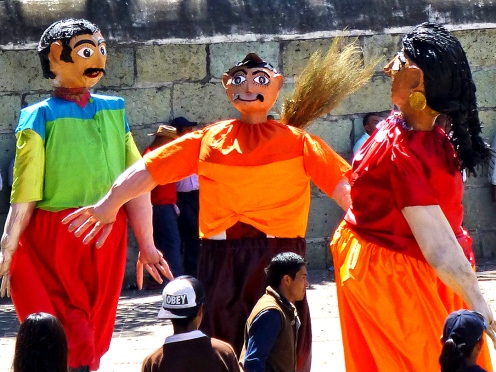 The colorful city of Oaxaca located between high
mountains in southern Mexico honors its traditions and its people with
celebrations starting on December 12 with a series of festivals and ending on
January 6 with the arrival of presents.
The colorful city of Oaxaca located between high
mountains in southern Mexico honors its traditions and its people with
celebrations starting on December 12 with a series of festivals and ending on
January 6 with the arrival of presents.
On December 12 the festivities start with Fiesta of
the Virgin of Guadalupe. According to Mexican legend, Virgin Mary, the mother
of Jesus in Christian religion, appeared to an Aztec Indian who lived during
the 1500s, a simple peasant named Juan Diego. She announced that she had come
to help Mexican Indians, giving hope and peace to many people. The Virgin of
Guadalupe is the name given to Mary as she appeared to Juan Diego. Each Christmas season starts with a celebration in her honor. Boys dress as Juan
Diego, and girls dress as
On December 16 nine nightly processions start. Two
children are chosen to lead the first procession. It begins with children
acting out the story of Mary and her husband, Joseph, on the night of Jesus’
birth. The two chosen children pretend to be searching for an inn to spend the
night. They lead their group to a neighbor’s house, where they are invited and
the celebration begins. Processions take place at different homes on each of
the nine nights before Christmas.
 On December 18 Fiesta of the Virgin of Soledad
follows. Soledad is the Spanish word for “solitude.” The Virgin of Soledad
represents the Virgin Mary after the death of her son, Jesus. This parade is a
serious event, where girls and boys dress in angel costumes, riding on a float
and honoring the Virgin of Soledad. Tall figures with huge, colorful heads
march and dance past the parade floats. A tower of fireworks is built and late
at night, the fuses are lit. Back at home, families set up Christmas displays
called nacimientos, showing nativity scenes with figures of Mary, Joseph, and
animals. The baby Jesus is missing as it awaits his birth on Christmas Day.
On December 18 Fiesta of the Virgin of Soledad
follows. Soledad is the Spanish word for “solitude.” The Virgin of Soledad
represents the Virgin Mary after the death of her son, Jesus. This parade is a
serious event, where girls and boys dress in angel costumes, riding on a float
and honoring the Virgin of Soledad. Tall figures with huge, colorful heads
march and dance past the parade floats. A tower of fireworks is built and late
at night, the fuses are lit. Back at home, families set up Christmas displays
called nacimientos, showing nativity scenes with figures of Mary, Joseph, and
animals. The baby Jesus is missing as it awaits his birth on Christmas Day.
January 6th the last day of festivities
is marked with the arrival of the Three Kings. Those children, who had to wait a
few more days for their presents, set their shoes outside by the door a day
earlier on January 5th. They hope that the Three Kings will remember
them.
Presents and treats are important parts of Christmas
in Oaxaca, but so is honoring the traditions of Mexican culture. Being with
friends and family is the best of all.
Source: A Mexican Christmas by Michael Elsohn Ross
This sounds like a very festive and unique way to celebrate Christmas.
ReplyDelete